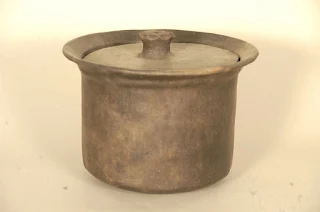HAMPAI Large size traditional vessel used by the socially dignified person for giving feast. |
Longpi village is located 40 Kms away from the Ukhrul district head quarter of Manipur. Majority of the villagers are potters who prepare handmade pots and household earthen ware as an important occupation in addition to their agricultural works. This age old skill of handmade pottery is inherited from their forefathers. Longpi Pot of Manipur has been able to attract large number of people from both the domestic and international arena. It is known not only for its unique shapes and innovated designs but also for the beautiful texture and metal like appearance normally used in various household functions either as kitchen utensils or decorative items for the fancy people.
Traditionally, Longpi potter used to prepare Hampai (pot of a dignified man) for the noble family and a man of social status other than the common household utensils. Hampais were used in massive food preparation during social feast and it happened to be the pride possession of a family symbolising the power, strength and richness in the society. With the growing demand of Longpi pots, the potters have stated introducing several innovated forms of this earthen ware.
 |
| Powder of local sandy clay |
+
 |
| Powder of local mineral stone |
=
 |
| Mixure of the above in a ratio of 2:1 (sandy clay being two times of the mineral stone grains) |
 |
| Kneading process |
 |
| Traditional tools used in making handmade black ware pottery by the Tangkhul tribe in Longpi village of Manipur |
Pot for brewing rice beer
Rice pot
Curry making vessel
Ricebeer Container (Ceremonial pot)
 |
| Bowl with stand used for consuming meal |
Container used for serving locally brewed rice beer
Pot used for drinking water
Decorated container
Decorated Container
Tea Cup
Traditional furnace for smoking tobacco
Decorated Mug for drinking rice beer (gender specific)
Decorated Mug for drinking rice beer (gender specific)
Cooking pot with lid
Cooking Vessel with lid
Photographs: Indira Gandhi Rashtriya Manav Sangrahalaya (IGRMS), Bhopal
















Comments
thanks
with regards,
Shakmacha Nongmaithem
mail me at angomsingh22@gmail.com
thanks
Regards!!
I'd like to see extra posts likе thiѕ .
my webpаge renfrew heating services
We are glad to hear that people have interest in Longpi pottery. We are supporting the artisans and their talent to provide a suitable platform.
For Longpi pottery you can write us at
info.creativecraft@gmail.com
Thanks
We are glad to hear that people like Longpi art. We are supporting artisans and their talent to provide a suitable platform for their growth.
For product inquiry you can contact us at
info.creativecraft@gmail.com
Thanks